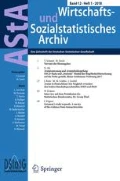Zusammenfassung
Der vorliegende Beitrag untersucht die Teilnahmeeffekte des Hamburger Kombilohnmodells mit Daten der Stichprobe der Integrierten Erwerbsbiografien. Hierfür werden neben dem Verfahren des Propensity Score Matching auch lineare Regressionen durchgeführt. Die so ermittelten Teilnahmeeffekte variieren nur geringfügig zwischen den beiden Evaluierungsmethoden. Jedoch ist die Ermittlung und Interpretation von heterogenen Teilnahmeeffekten mit linearen Regressionen einfacher als mit Matching Methoden. Insgesamt zeigen sich stark positive Teilnahmeeffekte, die bei Problemgruppen am Arbeitsmarkt höher ausfallen. Daher scheint das Hamburger Kombilohnmodell neben allgemein positiven Wirkungen auch zielgruppenorientiert zu sein.
Abstract
The paper evaluates the treatment effects of the wage subsidy program in Hamburg with propensity score matching as well as linear regressions. It is found that the estimated treatment effects differ only slightly between both methods. When analysing heterogeneous treatment effects, however, linear regressions are easier to implement and the results are easier to interpret than with propensity score matching. All in all, the program has significant positive effects, which are especially large for problem groups. Therefore, the Hamburg wage subsidy program has not only overall positive effects but also reaches the target group.
Literatur
Angrist JD (1998) Estimating the labor market impact of voluntary military service using social security data on military applicants. Econometrica 66:249–288
Blundell R, Costa Dias M (2002) Alternative approaches to evaluation in empirical microeconomics. Portug Econ J 1:91–115
Blundell R, Deardon L, Sianesi B (2004) Evaluating the Impact of Education on Earnings in the UK: Models, Methods and Results from the NCDS. The Institute for Fiscal Studies Working Paper 03/20, London
Caliendo M, Hujer R (2006) The microeconometric estimation of treatment effects – an overview. Allg Stat Arch 90:197–212
Caliendo M, Kopeinig S (2008) Some practical guidance for the implementation of propensity score matching. J Econ Surv 22:31–72
Dehejia R (2005) Practical propensity score matching: a reply to Smith and Todd. J Econ 125:355–364
Gerfin M, Lechner M (2002) Microeconometric evaluation of the active labour market policy in Switzerland. Econ J 112:854–893
Gerhardt M, Larsen IM (2005) Das ,,Hamburger Modell‘‘ zur Beschäftigungsförderung, Auswertungsbericht. Agentur für Arbeit und Behörde für Wirtschaft und Arbeit, Hamburg
Gerhardt M, Wielage N (2006) Kombilohnmodell – Praktikable Konzepte statt politischer Placebomaßnahmen. Wirtschaftsdienst 86:794–800
Hagen T, Fitzenberger B (2004) Mikroökonometrische Methoden zur Ex-post-Evaluation. In: Hagen T, Spermann A (Hrsg) Hartz-Gesetze – Methodische Ansätze zu einer Evaluierung. Nomos, Baden-Baden, S 45–72
Hamermesh DS (2000) The craft of labormetrics. Ind Lab Relat Rev 53:363–380
Heckman JJ, LaLonde RJ, Smith JA (1999) The Economics and econometrics of active labor market programs. In: Ashenfelter O, Card D (eds) Handbook of Labor Economics IIIA, S. 1865–2097
Heinze A, Pfeiffer F, Spermann A, Winterhager H (2005) Vermittlungsgutscheine – Zwischenergebnisse der Begleitforschung 2004, Teil III – Mikroökonomische Wirkungsanalyse. IAB Forschungsbericht Nr. 3/2005
Jirjahn U, Pfeifer C, Tsertsvadze G (2009) Mikroökonomische Beschäftigungseffekte des Hamburger Modells zur Beschäftigungsförderung – Evaluation eines Kombilohns. Schmollers Jb 129:37–82
Larsson L (2003) Evaluation of Swedish youth labor market programs. J Human Res 38:891–927
Lechner M (1999) Earnings and employment effects of continuous off-the-job training in East Germany after unification. J Bus Econ Stat 17:74–90
Leuven E, Sianesi B (2003) PSMATCH2: Stata module to perform full Mahalanobis and propensity score matching, common support graphing, and covariate imbalance testing. Software, http://ideas.repec.org/c/boc/bocode/s432001.html, Abrufdatum: 14.8.2008
Oi W (1962) Labor as a quasi-fixed factor. J Pol Econ 70:538–555
Rosenbaum PR, Rubin DB (1985) Constructing a control group using multivariate matched sampling methods that incorporate the propensity score. Amer Stat 39:33–38
Rässler S (2006) Der Einsatz von Missing Data Techniken in der Arbeitsmarktforschung des IAB. Allg Stat Arch 90:527–552
Author information
Authors and Affiliations
Corresponding author
Rights and permissions
About this article
Cite this article
Pfeifer, C. Homogene und heterogene Teilnahmeeffekte des Hamburger Kombilohnmodells: Ein Verfahrensvergleich von Propensity Score Matching und linearer Regression . AStA Wirtsch Sozialstat Arch 3, 41–65 (2009). https://doi.org/10.1007/s11943-009-0055-1
Received:
Accepted:
Published:
Issue Date:
DOI: https://doi.org/10.1007/s11943-009-0055-1

